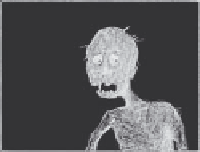Graphics Reference
In-Depth Information
Space and scale
Being about puppets existing in real physical environments, space is very important to stop
motion, and we try to make i lms that contain both intimate close-ups and huge, epic, wide
shots. A i lm full of close-ups hardly realises the potential of animation: we want to give our
characters somewhere to move around in, and not just be about talking heads. Inevitably most
studios are tight for l oor space and these wide open spaces have to be suggested through
other means. Drawn i lms and CG can do this easily, and thankfully blue screens and digital
imagery make this relatively easy for us today, as all manner of sets and landscapes can be put
in at the postproduction stage, without eating into expensive studio space. Before this luxury,
animators came up with all manner of creatively inventive ways to suggest sets and landscapes
disappearing of into the distance.
One of the main problems is to give an impression of scale, not just imagining the puppets
to be bigger than they are, but also giving the illusion that the sets go on for miles. Focus is
the real problem here, as even softly painted hills a few feet away from the main set look like,
well, what they are. Trying to get a sense of distance is very important for a credible illusion.
At Cosgrove Hall, the i rst time we tried this was on
Pied Piper
, using a large seamless gauze
between a midground piece of landscape and a background hill. Suddenly, with its density
diminished, the hill looked a long way back in the distance. It's an old, cheap and simple trick,
but it works every time. Gauze is also useful for l ying cut-out birds, as I tend to in every i lm,
and for shining shafts of sunlight or moonlight. Clouds can be easily attached.
At the beginning of
Hamilton Mattress
is an epic wide shot of the savannah, backed by a huge
gauze on a metal frame. I wanted the ef ect of the sun rising and burning away the clouds to
a clear sky, as the day became hotter. Today we might have done it in CG and achieved even
more scale, but even then there is no button marked 'easy shrinking clouds. So our animators
gamely moved this epic gauze a millimetre each frame, snipping away at the cottonwool
clouds until the clouds, in ef ect, evaporated. Complicating this was a huge heavy sun rising
slowly, and several characters moving across the set in the midground. If that wasn't enough,
we wanted a lake shimmering in the distance. A simple piece of mirror foil was ef ective, but
the lake itself looked dead, so we put a Perspex rod covered with silver thread along its horizon
line, as well as several threads across the lake itself, and when these were twanged each frame,
the lake looked as though it was glistening in the morning sun. The set was probably twenty-
i ve feet across and about i fteen feet deep. To help the scale even more we made several
anthills of dif erent proportions, with tiny ones placed at the back of the set. This all looked
pretty magnii cent, but was time consuming and a hard, hot set to shoot on. The sheer scale
of it meant that to allow access for the animators, channels had to be constructed in the set,
that were either invisible to the camera or disguised as canyons. It's an odd experience to see
this epic set, and then watch as an animator pops up, totally ruining the illusion of scale. I enjoy
simple physical ef ects on set, and the lake here worked amazing well.
What would have helped with the epic opening shot of
Hamilton Mattress
even more
would have been to build small-scale versions of the puppets themselves, but that
would have been expensive. Probably today we might have animated the characters
on a blue screen, enabling us to control their size more. We used, almost successfully,
various scaled puppets on
The Wind in the Willows
, but it becomes complicated, with
the need for small-scale duplicate props and so on.


Search WWH ::

Custom Search